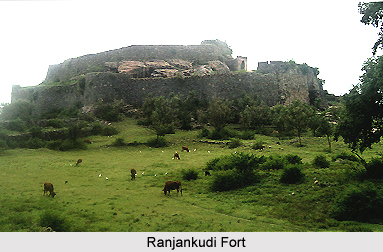 Ranjankudi Fort is an ancient fortress which is located at a distance of 17 km towards the north of Perambalur town in the district of Perambalur in Tamil Nadu. The fort was built in 17th century by a feudatory of the Nawabs of Arcot.
Ranjankudi Fort is an ancient fortress which is located at a distance of 17 km towards the north of Perambalur town in the district of Perambalur in Tamil Nadu. The fort was built in 17th century by a feudatory of the Nawabs of Arcot.
History of Ranjankudi Fort
Ranjankudi is also called "Ranjankudi Kottai" and also referred as "Nanjankudi Kottai". The fort is believed to have been constructed by Jagridar of the Nawab of Carnatic during the 17th century. Ranjankudi Fort played a significant part in the Battle of Valikonda between Chanda Sahib and Mohamed Ali Khan Walajan in 1751. Chanda Sahib was supported by the French East India Company and Mohamed Ali Khan Walajan was aided by the British East India Company. While the French won the initial battle, the British ended up winning the final battle with the help of local Muslims.
In May of 1752, the fort was also the scene of surrender of French troops under D`Auteuil, which was sent to relieve the garrison at Srirangam. British denied entry of the French troops to the upper level of the fort. D`Auteuil surrendered in the fort. Presently, the old premise is believed to have been housing Hindu temples dedicated to Shiva and Hanuman.
Architecture of Ranjankudi Fort
The fort is oblong in shape with semicircular bastions and a moat encircling it. There are 3 fortifications at different levels which are built with cut stone blocks. The lower bastion is the main rampart surrounded by mud wall. The open ground known as "Pettai" is approached through a flight of steps, which was once a battlefield. The top-tier is called "Kottai Medu" which was used as guarding towers by soldiers and housing cannons. The small water body in the fort is believed to have been used by the Nawab as swimming pool.
The fort has a palace, residence buildings, underground chamber and an underground passage that links Pettai with Kottai Medu. The pit in the centre of the fort was used as a prison for male prisoners while female prisoners were jailed in small blocks inside the fort. The fort is one of the prominent tourist destinations in Perambalur. Presently the Fort of Ranjankudi is maintained by the Government of Tamil Nadu.
How to Reach Ranjankudi Fort
Ranjankudi is 17 km north of Perambalur. The nearest airport is Tiruchirapalli Airport and the railhead is Ariyalur Railway Station.



















